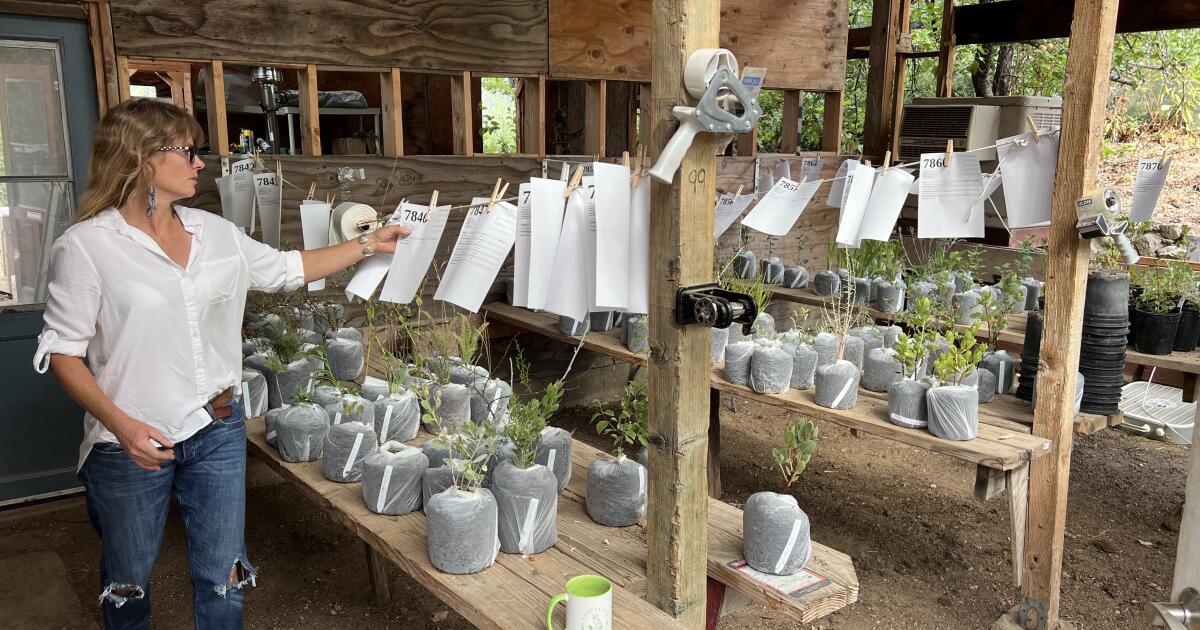
Happy October, dear readers! I am in deep disbelief that we’re somehow nearing the end of 2025, but orb-weaver spiders — those great harbingers of fall — are already out in force in my Ventura yard, stringing “Gotcha!” webs across my porch and all my walkways. So I guess it must be so.
I have so many activities to share with you in the plants calendar below — note especially that October is the opening gate for many of SoCal’s native plant nurseries. But first, I want to talk about Las Pilitas Nursery, one of California’s oldest and most respected native plant nurseries with a huge SoCal clientele athough it’s based in a very rural part of the Central Coast.
In 1974, about four years before Mike Evans and Jeff Bohn set out to start the Tree of Life native plant nursery outside San Juan Capistrano, Bert and Celeste Wilson, two cash-strapped but seriously dedicated Cal Poly San Luis Obispo students, started growing native plants in their backyard for Bert’s landscaping jobs. And in 1978, they purchased land in the remote oak-covered hills outside Santa Margarita to start their own native plant nursery.
Celeste had a master’s degree in biology and a deep love for plants and the outdoors. Bert was a chemistry major working on his master’s degree and trying to make ends meet by doing landscaping jobs in San Luis Obispo. And together, they had a brand-new responsibility — their baby daughter, Penny.
Their second child, Ian, would come four years later. Bert never finished his thesis, according to his daughter, Penny Nyunt, because he and Celeste were too busy raising their family, building greenhouses and embracing an almost unheard-of idea in the late 1970s: landscaping with native plants.
“Something he really pushed was the idea of not changing your garden for the plants, but picking plants that actually live in your environment,” Nyunt said while giving me a mid-September tour of the sprawling nursery, laced by towering oaks, more than 40 varieties of manzanita and a to-do list of repairs, orders and planting jobs that could bring the Energizer Bunny to his knees.
Nyunt, a biologist who also earned her degree at Cal Poly SLO, and her husband, Zin, a Caltrans engineer, live just over the hill from the nursery. She used to walk the trail between her house and the nursery regularly, until she spotted a cougar. She helped at the nursery as a teen, a college student and a young mother, especially as her mother’s health declined, but abruptly took over daily operation of the nursery when Bert, a man “in constant motion,” died in his sleep in March 2014 at age 62.
There wasn’t time to grieve or even process the death of her larger-than-life father, Nyunt said, because the nursery had so many plants that had been ordered and needed to be shipped. So overnight, she started working full time at the nursery to fulfill orders. Her brother joined her soon after to help keep the business alive because their mother wasn’t well enough to do the work herself.
They had to close their satellite store in Escondido — it was just too much to manage from afar — but the nursery is still open every Saturday for retail sales in Santa Margarita between October and May. Online sales continue year-round, fulfilling native plant orders from as far away as Washington and Utah. More than half, however, come from gardeners in Southern California, Nyunt said, especially from Angelenos, seduced by the nursery’s many native cultivars and selections and her father’s funny, useful and precedent-setting website.
It wasn’t just the plants that made the nursery special, although Bert did nurture many landscape-worthy selections he found in the wild, such as the famous Hollywood Flame California fuchsia he discovered growing in the hills of Los Angeles or hybrids like Baby Bear manzanita, Nyunt’s favorite, that just started growing out of the ground in one of the old greenhouses, likely a cross-pollination between other manzanitas on site.
But the top sellers are a couple of cultivars Bert introduced known as Margarita Bop, an electric-blue native penstemon and salvia “Pozo Blue,” a fragrant purple sage “that’s loved by pollinators, incredibly tough and easy to grow,” Nyunt said.
Many of those introductions are staples at other nurseries today because Bert never patented his finds, Nyunt said. “He just cared about people using the plants,” she said. “We were the only ones talking about [native plants then] and he was really good at it. We had so much traffic on our website, people started going to their local nurseries asking them to stock these plants.”
Bert discovered the potential of the World Wide Web in the early 1990s, when the internet was very new. He taught himself programming and created a website for Las Pilitas so people could order plants online. He became one of the earliest nursery owners to sell plants by mail, Nyunt said, but his website was far more than a catalog of what the nursery grew and sold.
In his spare hours, when it was too dark to work outside or before breakfast in the morning, Bert poured everything he knew into that website, Nyunt said, creating pages for every plant he sold, with photos and often humorous text, and explaining their care and best growing regions.
“He wrote a book,” Nyunt said, “but instead of publishing it, he discovered the internet and was like, ‘Wow, I could just make all this information available to the masses, and it would be a great way to advertise us and promote California native plants.’”
His website inspired many of today’s native plant proponents and has become legendary in the California native plant world. Before the California Native Plant Society introduced its comprehensive Calscape native garden planning tool, for instance, Bert created a page on his website that let visitors enter their ZIP Codes to determine what native plant communities were best for their region, Nyunt said.
He was one of the first to explain the importance of mycorrhizal fungi and provide easy-to-understand explanations for everything, from understanding pH levels to the problem with reseeding fire-scarred areas with nonnative grasses that ultimately become invasive weeds. He even included in-depth instructions about how to build a garden chair from wooden pallets.
“He wanted to make things simple for the average person,” Nyunt said. He encouraged the use of “appropriate” mulch, based on the needs of the plants, but railed against using manure and other soil amendments (“Don’t treat natives like broccoli,” was one of his famous sayings) and drip irrigation, which he maintained could severely shorten the lifespan of native plants. (“Drip … seems as barbaric as throwing young women into volcanoes to make your corn grow,” he wrote.)
A lot of family-owned nurseries have closed in the last few years, mostly because younger family members weren’t interested in carrying on the business, especially when they could sell the property for a whole lot more money than they’d likely make selling plants.
Nyunt said she and her brother understand this very well. “We couldn’t do this if we didn’t have spouses whose jobs can support us,” she said. Bears, raccoons and other critters frequently uproot their seedlings. Heavy snows have flattened their greenhouses more than once, and they rely heavily on their only full-time employee, Glenn Baker-Ballantyne, to help Nyunt get plants seeded, propagated, potted and shipped.
But Las Pilitas is more than a business to Nyunt — it’s part home and part family legacy. Her father’s work was crucial in making California native plants “mainstream and accessible,” Nyunt said. “He dedicated his life to California native plants, and I feel like he is quickly being forgotten.”
Not on Nyunt’s watch. There’s a large photo of Bert in the retail section, sitting on one of his wood-pallet chairs, along with a few of the cultivars he introduced to the gardening world.
By all means, visit the Las Pilitas website and get your orders in early. But if you have a spare weekend, go there in person. It’s a lovely drive through blond hillsides dotted with sprawling oaks, and there’s something wonderful about walking through this still-flourishing native plant nursery that two prescient idealists created in the wilderness 47 years ago.
This has been a tough year for lots of reasons, especially for those who lost their homes in the Eaton and Palisades fires, so maybe that’s why I’m already hearing lots of holiday buzz; we’re all desperate for something to celebrate. Altadena can look forward to a couple of events: the annual Winter Festival and Lighting Ceremony for Christmas Tree Lane on Dec. 6 and the new Winter Bloom Market & Gathering at Odyssey Charter School on Nov. 29 and 30, in part to celebrate the work of more than 100 local artists and vendors.
I’m mentioning the Winter Bloom market now because organizers want to provide a few holiday ornaments to Altadenans who lost all their belongings in the Eaton fire this year. So they’ll need plenty of donations. You can help by donating holiday ornaments, stars, menorahs and kinaras that are “vintage, meaningful, handcrafted or uniquely beautiful,” according to the website, along with a short note explaining the story behind your donation. Donations can be mailed or dropped off at Prime Pizza in Altadena and Plant Material in Silver Lake and Glassell Park.
In other fire-restoration news, students and staff from Seven Arrows Elementary in Pacific Palisades, EF Academy in Pasadena and Saint Mark’s School in Altadena have started work with the Jane Goodall Institute on a new TREEAMS (short for Trees + Dreams) student-led movement to plant 5,000 trees around fire-destroyed parts of Altadena and Pacific Palisades over the next five years, starting in April. “The project seeks to transform grief into action by restoring burned landscapes, replanting lost trees, and cultivating resilience,” wrote one of the organizers, Shawna Marino. The organizers are looking for more schools interested in participating in the project and at least $200,000 in donations to kick-start the project, which they estimate will require about $2 million over the next five years. For more information visit their website, treeams.org.
Upcoming events
Ongoing
Westwood Greenway’s automatic gates are now open, and visitors can walk through the stream-laced trail planted with native plants between Overland Avenue and Westwood Boulevard in Rancho Park from 8 a.m. to 6 p.m. westwoodgreenway.org
TreePeople’s the Plants of Tovaangar project now lets people hear the names of many California native plants pronounced in the native tongue of the region’s Indigenous Tongva people as part of an interactive audio tour of Coldwater Canyon Park in Beverly Hills. You can also hear the names and pronunciations online. treepeople.org
Through Oct. 18
Bloom Town Flower Co. Fall Bulb Sale, an online sale from the Covina-based flower farm features tulips, anemone, ranunculus and daffodil bulbs that grow well in Southern California. bloomtownflowerco.com
Oct. 1
The impact of nonnative plants on local ecosystems, a talk by landscape architect Shelley Sparks at the Cherry Blossom Garden Club meeting at 10 a.m. in the Sepulveda Garden Center in Encino. Admission is free. facebook.com
Oct. 2-4
Mt. San Antonio College’s Horticulture Unit Plant Sale, 9 a.m. to 4 p.m. Oct. 2-3 and 9 a.m. to noon on Oct. 4 at the Los Angeles County Arboretum in Arcadia. The sale features a variety of low-water ornamental plants, California native plants, fruit trees and shrubs, vegetables and herbs grown by students working on horticulture degrees at Mt. SAC. Proceeds will support the college’s horticultural programs. Free with $18 admission to the arboretum ($14 for seniors 62 and older and students with ID; $8 for children ages 3-12, free for members and children 2 and younger). arboretum.org
Oct. 3
Botanical Cocktails: A Garden-to-Glass Experience, a special cocktail demonstration class led by Whiskey Loves Basil, at California Botanic Garden in Claremont from 6 to 7:30 p.m. Learn how to craft three original cocktails using handmade botanical syrups. Participants must be at least age 21 to attend and sample each drink. Register online, $55 ($45 members). calbg.org
Oct. 4
LA Nature Quest: the Adventure Begins at Griffith Park, 9 a.m. to noon at the Griffith Park Visitor Center, launching the citywide project (formerly know as the LA BioBlitz Challenge) for Angelenos to photograph wild plants, animals, insects and fungi in their neighborhoods through the month of October. The photos will be used by scientists to track the city’s biodiversity. The free event is sponsored by the Los Angeles Public Library, L.A. Sanitation, the Natural History Museum of Los Angeles County, Los Angeles Rec & Parks and the Los Angeles Department of Water & Power. Registration is required. eventbrite.com
South Coast Chapter of the California Native Plant society 2025 Fall Plant Sale, 10 a.m. to 2 p.m. at the Madrona Marsh Nature Center in Torrance. Members of CNPS and the Friends of Madrona Marsh can enter at 9 a.m. chapters.cnps.org
Adopt a Plant from among 2,000 free houseplants, 11:30 a.m. to 4 p.m. at the Plant Chica store in Leimert Park. instagram.com
Black Thumb Farms Open Farm Days, 9 a.m. to noon at the farm in Panorama City. This is a hands-on volunteer event the first Saturday of every month through December for teens, families and educators to learn how to prepare the farm for the next growing season. Participation is free, but registration is required. blackthumbfarm.org
Oct. 5
Conejo Cactus & Succulent Society Succulent & Cactus Plant Sale, 9 a.m. to 4 p.m. in Thousand Oaks. The event also includes vendors selling pottery, jewelry and bromeliads as well as experts who can provide information about growing and caring for the plants. Admission is free. conejocss.com
From Plot-to-Plate Fundraiser and Cooking Demo, 1 p.m. at the Eagle Rockdale Community Garden in Eagle Rock, has a goal of raising $5,000 for the Los Angeles Community Garden Council’s mission to support community gardens in Los Angeles. Chef Jocelyn Ramirez, an L.A. native and founder of Todo Verde seasonings, will demonstrate recipes using fresh, local harvests and true-to-culture plant-based cooking. Tickets start at $25 and $50. lagardencouncil.org
“Pineapple: the Cosmopolitan Bromeliad,” a talk by conservationist Sandy Masuo, botanical content specialist for the Huntington, for the South Bay Bromeliad Associates’ October meeting at 1:30 p.m. at the Palos Verdes Library Community Room in Rolling Hills. Admission is free. facebook.com
Oct. 6, 13, 20, 27 and Nov. 3
MiniNature Reservists Native Plant Propagation Course, a free training course for 30 Ventura County students ages 13 and older to learn how to propagate and care for native plants, 6 to 8 p.m. in Oxnard. The instructor is Carlos Martinez, owner of Public Lands Native Nursery, opening a retail store in Santa Paula this fall. Graduates will receive hands-on learning as well as a selection of native plants and a green workforce certification for résumés. Applications close 11:59 p.m. on Oct. 4. mininature.org
Oct. 17,14, 21
3-Part California Native Garden Design, led by landscape designer Steve Gerischer of Larkspur Garden Design, 9:30 a.m. to 1:30 p.m. all three days at the Theodore Payne Foundation nursery in Sun Valley. Participants are expected to also take the foundation’s introductory online Right Plant, Right Place class offered Oct. 8. Register for the design class online, $396.11 for one person or $471.96 for two people working on the same design. events.humanitix.com
Oct. 11-12
California Botanic Garden Grow Native Nursery Fall Plant Sale, 10 a.m. to 4 p.m. both days at the nursery in Claremont. Members can enter between 8 and 10 a.m. on Oct. 11 and get a 10% discount on all plant purchases. calbg.org
Oct. 11
The West L.A. Chapter of the California Rare Fruit Growers Annual Plant Sale, 10:30 a.m. to 12:30 p.m. at the Veterans Memorial Building in Culver City. The sale includes rhubarb plants that grow well in Southern California as well as variety of unusual (and usual) fruit trees cultivated by members. wla.crfg.org
Lotusland’s Exceptional Plants Auction, 1 to 4 p.m. in Montecito, featuring hard-to-find specimens through silent and live auctions “ranging from accessible $30 treasures to rare, high-value plants such as a one-of-a-kind cycad hybrid (Encephalartos woodii x E. horridus),” according to the website. Other unusual offerings include the corpse flower (Amorphophallus titanum), a rarely seen 1972 Begonia ‘Francis Fickewirth,’ and specimens propagated at Lotusland from plants at the Huntington, L.A. County Arboretum, UC Santa Barbara and private collectors such as master rosarian Dan Bifano. Reserve tickets online, price start at $175 ($125 for members). lotusland.org
Otto & Sons Nursery Perennial Companion Planting 101, a free class about flowering perennials that attract pollinators and beneficial insects, 10 to 11 a.m. at the nursery in Fillmore. No sign-up is required. ottoandsonsnursery.com
Oak Gall Ink, a class led by L.A. artist Kim Russo in making ink galls created when wasps lay eggs on an oak branch, 2:30 to 4:30 p.m. at the Theodore Payne Foundation nursery in Sun Valley. Participants are asked to bring their own mallet, small hammer or rolling pin for smashing galls and a clean jar (at least 8-ounce) with tight-fitting lid to hold the ink. Wear clothes that can get messy. Register online, $79.22. events.humanitix.com
L.A. County Arboretum presents the Monstrous Garden, an adults-only Halloween-themed look at botanical “monsters” during a tour of the gardens from 4 to 7 p.m. The event includes light refreshments and a “seasonal adult beverage”; participants must be age 21 or older. Register online, $45 ($40 members). arboretum.org
Oct. 12
California Botanic Garden Herb Walk: Medicinal Plants of California, 9 to 11 a.m. at the garden in Claremont, led by herbalist William Broen during an interactive garden walk and talk about medicinal and edible plants native to California. The two-hour loop walk covers less than a mile with frequent stops. Register online $30 ($25 members). calbg.org
Growing Euphorbias, a talk by horticulturist Al Klein, owner of Botanic Wonders nursery in Vista, for the October meeting of the South Coast Cactus & Succulent Society from 11 a.m. to 2 p.m. in McTaggart Hall at the Fred Hesse Jr. Community Park in Rancho Palos Verdes. Admission is free. southcoastcss.org
Oct. 14, 20
Birding in the Garden, 8:30 to 10:30 a.m. both days at Taft Gardens near Ojai. Avian biologist Peter Larramendy will discuss the basics of birding and common birds found in the Ojai Valley while walking through the garden. Register online, each day is a separate event, $35. taftgardens.org
Oct. 17-18
Things That Go Bump in the Night at the California Botanic Garden in Claremont from 5:30 to 9 p.m. Exhibitors include the Pomona Valley Bird Alliance, Guardians of the Wolves, SoCal Bat Working Group, the Invertebrate Club of Southern California, scientists from the Claremont Colleges and a night hike guided by the Sierra Club as well as “creepy crawly crafts,” “The World Famous Spider Show,” a comedy bug presentation, and, on Oct. 17 only, a live puppet show by the Bob Baker Marionette Theater. Purchase tickets online, $21 ($17 for seniors and students with ID) and $15 for children ages 3-12. Tickets for members are $16 ($12 for seniors and students with ID, $10 for children ages 3-12). calbg.org
Oct. 17-19
The Huntington’s 9th International Orchid Show and Sale, 10 a.m. to 5 p.m. all three days at the Huntington’s Brody Botanical Center. The event includes a dozen exhibitors from clubs and organizations around Southern California as well as more than 20 vendors from California, Washington, Ecuador, Japan, Taiwan and Thailand. The show is free with $29 to $34 admission to the garden depending on the day; $24-$28 for seniors 65-plus, active military and students with ID; $13-$15 for ages 4-11; free to members and children age 3 and younger. Note that reservations are required for entry Friday-Sunday. huntington.org
Oct. 18
Intro to Fire Defensible Garden Design, a workshop in creating a fire-wise garden led by Theodore Payne Foundation educator Erik Blank, 9:30 a.m. to 1 p.m. at the foundation nursery in Sun Valley. Register online, $105.19. events.humanitix.com
South LA Tree Coalition 2025 Jefferson Park Community Planting Event, 10 a.m. to 2 p.m. at 6th Avenue Elementary School in Jefferson Park. The event will provide 100 fruit trees for adoption by Jefferson Park residents in the 90018 ZIP Code. Preregistration required. Volunteers are also needed to help with planting trees during the event, which will include vendors, entertainment, food and information booths. southlatrees.org
San Diego Chapter of the California Native Plant Society Native Plant Sale, 9 a.m. to 3 pm. at the Sikes Adobe Historic Farmstead in Escondido. The sale includes California native plants, seeds and bulbs. Admission is free; tours of the historic farmstead are available for a suggested donation of $3. cnpssd.org
Oct. 19
Autumn in the Garden 2025: 20 Years of Arlington Garden, a celebration to support “20 years of growing a garden instead of a freeway” at Pasadena’s free community garden. Proceeds will support the garden. Tickets start at $100, ($35 for ages 5-15); VIP tickets start at $215.26. eventbrite.com
Oct. 24
The ABCs of California’s Native Bees, a talk by photographer and native bee expert Krystle Hickman, author of the new book by the same name, from 2 to 3:30 p.m. at the Theodore Payne Foundation nursery in Sun Valley. Register online, $42.85. events.humanitix.com
Oct. 25-26
Southern California Chrysanthemum Society Chrysanthemum Show, 10:30 a.m. to 4 p.m. at Sherman Library & Gardens in Corona del Mar. Expect multiple shapes, sizes and colors of the flower known as the “Queen of Fall.” Free workshops are offered Oct. 25 about the 13 varied chrysanthemum classes in the U.S. and on Oct. 26 on the history of chrysanthemums. Both classes are at 11:30 a.m. and are free, along with the show, with $5 admission to the garden (members and children age 3 and younger enter free). thesherman.org
Oct. 25
Mojave Desert Land Trust Annual Native Plant Sale, 9 a.m. to 1 p.m. at the trust offices in Joshua Tree. Expect more than 85 species of California native plants designed for desert living. New species this year include desert needlegrass (Stipa speciosa), desert fluffgrass (Dasyochloa pulchella) and winterfat (Krascheninnikovia lanata). A full list of available plants will be listed on the website by mid-October. Admission is free, but this popular sale attracts hundreds, so it’s wise to arrive early. mdlt.org
Adult Night Hike: the Ghoulish Garden, a guided walk exploring the sinister side of plants from 7:30 to 9 p.m. at the Los Angeles County Arboretum in Arcadia. Register online, $25 ($20 members). arboretum.org
Grow Native Plants: Hands-On Seed Propagation, a hands-on class taught by California Botanic Garden Nursery Coordinator Hugo Sopeña from 9 to 11 a.m. at the garden in Claremont. Participants will go home with a flat of seeds they planted during the class. Register online, $45 ($35 members). calbg.org
Spooky Species of Theodore Payne: An ID Walk and Talk with California naturalist and educator Jason “Journeyman” Wise from 10 a.m. to noon on the Theodore Payne Foundation grounds in Sun Valley. Open to all ages. Halloween costumes are fine as long as they don’t inhibit walking; closed-toe walking shoes strongly recommended. Register online, $42.84. events.humanitix.com
Botany of Oaks: A Native Tree Workshop, learn how to identify and care for California native oaks; led by consulting botanist Alison Lancaster from 2 to 4:30 p.m. on the Theodore Payne Foundation grounds. Register online, $68.83. events.humanitix.com
Día de los Muertos: Joy as Resistance, Black Thumb Farm’s annual celebration and fundraiser in Panorama City — this year for Amor al Valle — to support families affected by recent ICE raids. The free event includes natural tie-dye workshops, cooking demos and arts and crafts for all ages. Food is available for purchase. Admission is free, but registration is required. docs.google.com
Eat Native Plants! Food, Culture and Land Back, a free interactive cooking demonstration of how Indigenous Chumash people cooked with native acorns, organized by the MiniNature Reserve native plant nursery and landscapers, at 1 p.m. in Oxnard. Reservations are required. eventbrite.com
Oct. 28-Nov. 8
Theodore Payne Foundation Fall Plant Sale. The Sun Valley nursery kicks off prime planting season for California native plants with its biggest assortment of the year from 8:30 a.m. to 4:30 p.m. daily, except Nov. 2-3 when the nursery is closed. Admission is free; parking reservations are available but not required. events.humanitix.com
Nov. 1
Grow Native Plants: Introduction to Landscape Design for California Native Plants taught by Nathan Peterson, landscape architect and education staff member at California Botanic Garden, 9 to 11:30 a.m. at the garden in Claremont. Learn the basic steps of choosing layout options and making plant selections for a native landscape design. Register online, $45 ($35 members). calbg.org
What we’re reading
This involves a different kind of planting, but it’s still a terrific story by my Times colleague Jack Flemming about the reaction from Woodland Hills residents now that Boething Treeland Nursery, a 73-year-old fixture in the community, is slated to become a cemetery.
More than 200 Angelenos showed up to comment on proposed “zone zero” rules on Sept. 18 requiring all combustible materials, including plants, to be removed within five feet of structures in very high fire hazard severity zones protected by city and county firefighters and areas protected by state firefighters. There’s still time to comment before the state Board of Forestry and Fire Protection’s Zone Zero Subcommittee issues its final recommendations for the regulations on Nov. 5.



